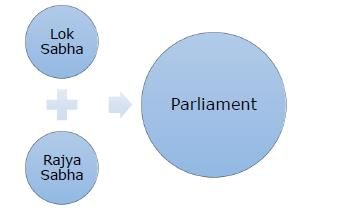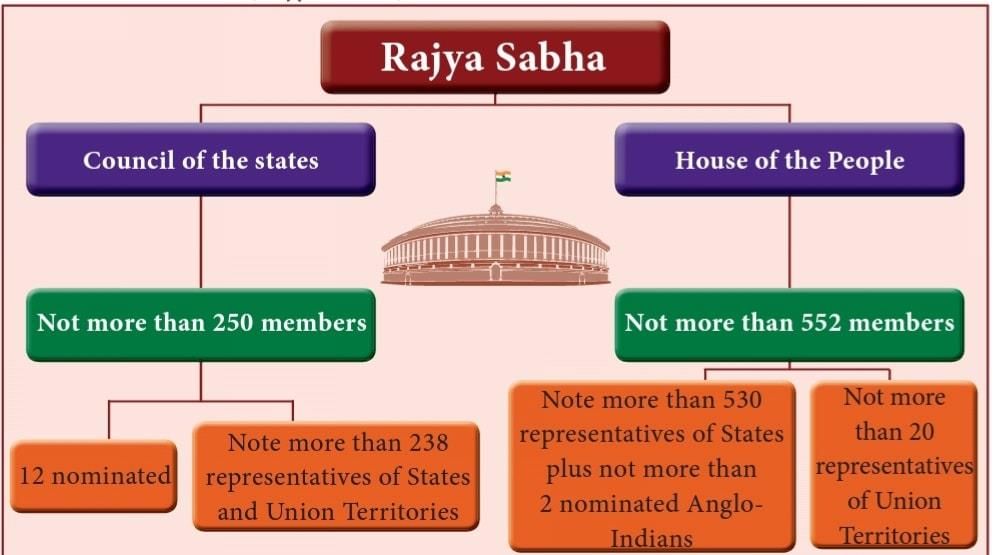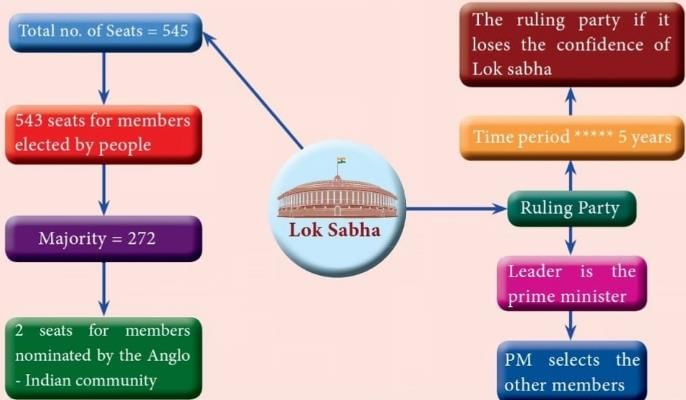UPSC Exam > UPSC Notes > Indian Polity for UPSC CSE > NCERT Summary: Legislature- 1
NCERT Summary: Legislature- 1 | Indian Polity for UPSC CSE PDF Download
Introduction
Legislation are elected by the people and work on behalf of the people. Here you would study how elected legislature function and help in maintaining the democratic government. You will also learn about the composition and functioning of the parliament and State legislature in India and their importance in democratic government.
 1. Why do we need a Parliament?
1. Why do we need a Parliament?- Legislature is not merely a law making body. Lawmaking is but one of the functions of the legislature. It is the centre of all democratic political process. It is packed with action, walkouts, protests, demonstrations, unanimity, concern, and co-operation. All these serve very vital purposes; Indeed, a genuine democracy is inconceivable without are presentative, efficient and effective legislature. The legislature also helps people in holding the representatives accountable. This is indeed, the very basis of representative democracy.
- Yet, in most democracies, legislatures are losing central place to the executive. In India too, the Cabinet initiates policies, sets the agenda for governance and carries them through. This has led some critics to remark that the Parliament has declined. But even very strong cabinets must retain majority in the legislature.
- A strong leader has to face the Parliament and answer to the satisfaction of the Parliament. Here in lies the democratic potential of the Parliament. It is recognized as one of the most democratic and open forum of debate. On account of its composition, it is the most representative of all organs of government. It is above all, vested with the power to choose and dismiss the government.
2. Why do we need two Houses of Parliament?
- The term ‘Parliament’ refers to the national legislature. The legislature of the States is described as State legislature. The Parliament in India has two houses. When there are two houses of the legislature, it is called a bicameral legislature.
- The two Houses of the Indian Parliament are the Council of States or the Rajya Sabha and the House of People or Lok-Sabha. The Constitution has given the States the option of establishing either a unicameral or bicameral legislature. At present only five States have a bicameral legislature?

- Countries with large size and much diversity usually prefer to have two houses of the national legislature to give representation to all sections in the society and to give representation to all geographical regions or parts of the country.
- A bicameral legislature has one more advantage. A bicameral legislature makes it possible to have every decision reconsidered. Every decision taken by one house goes to the other house for its decision. This means that every bill and policy would be discussed twice. This ensures a double check on every matter. Even if one house takes a decision in haste, that decision will come for discussion in the other house and reconsideration will be possible.
Rajya Sabha
Rajya Sabha
Rajya Sabha
- Each of the two Houses of the Parliament has different bases of representation. The Rajya Sabha represents the States of India. It is an indirectly elected body. Residents of the State elect members to State Legislative Assembly. The elected members of State Legislative Assembly in turn elect the members of Rajya Sabha. We can imagine two different principles of representation in the second chamber. One way is to give equal representation to all the parts of the country irrespective of their size or population. We may call this as symmetrical representation.

- On the other hand, parts of the country may be given representation according to their population. This second method means that regions or parts having larger populations would have more representatives in the second chamber than regions having less population.
- In the U.S.A., every state has equal representation in the Senate. This ensures equality of all the states. But this also means that a small state would have the same representation as the larger states. The system of representation adopted for the Rajya Sabha is different from that in the USA. The number of members to be elected from each State has been fixed by the fourth schedule of the Constitution.
- What would happen if we were to follow the American system of equality of representation in the Rajya Sabha? Uttar Pradesh with a population of 17.18.29 lakhs would get seats equal to that of Sikkim whose population is only 5.71 lakhs. The framers of the Constitution wanted to prevent such discrepancy. States with larger population get more representatives than States with smaller population get. Thus, a more populous State like Uttar Pradesh sends 31 members to Rajya Sabha, while a smaller and less populous State like Sikkim has one seat in the Rajya Sabha.
- Members of the Rajya Sabha are elected for a term of six years. They can get reelected. All members of the Rajya Sabha complete their terms at the same time. Every two years, one third members of the Rajya Sabha complete their term and elections are held for those one third seats only. Thus, the Rajya Sabha is never fully dissolved. Therefore, it is called the permanent House of the Parliament.
- The advantage of this arrangement is that even when the Lok Sabha is dissolved and elections are yet to take place, the meeting of the Rajya Sabha can be called and urgent business can be conducted.
- Apart from the elected members, Rajya Sabha also has twelve nominated members. The President nominates these members. These nominations are made from among those persons who have made their mark in the fields of literature, arts, social service, science etc.
Question for NCERT Summary: Legislature- 1Try yourself:Who/what of the following is not a part of the Parliament of India?
View SolutionLok Sabha
Question for NCERT Summary: Legislature- 1
Try yourself:Who/what of the following is not a part of the Parliament of India?
View Solution
Lok Sabha
- The Lok-Sabha and the State Legislative Assemblies are directly elected by the people. For the purpose of election, the entire country (State, in case of State Legislative Assembly) is divided into territorial constituencies of roughly equal population. One representative is elected from each constituency through universal, adult suffrage where the value of vote of every individual would be equal to another. At present there are 543 constituencies. This number has not changed since 1971.
- The Lok-Sabha is elected for a period of five years. This is the maximum. We have seen in the chapter on the executive that before the completion of five years, the Lok-Sabha can be dissolved if no party or coalition can form the government or if the Prime Minister advices the President to dissolve the Lok-Sabha and hold fresh elections. Apart from law making, the Parliament is engaged in many other functions. Let us list the functions of the Parliament.

- Legislative Functions: The Parliament enacts legislation for the country. Despite being the chief law-making body, the Parliament often merely approves legislations. The actual task of drafting the bill is performed by the bureaucracy under the supervision of the minister concerned. The substance and even the timing of the bill are decided by the Cabinet. No major bill is introduced in the Parliament without the approval of the Cabinet. Members other than ministers can also introduce bills but these have no chance of being passed without the support of the government.
- Control Executive and ensuring its accountability: Perhaps the most vital function of the Parliament is to ensure that the executive does not overstep its authority and remains responsible to the people who have elected them.
- Financial Function: Government is about spending a lot of money on various matters. Every Check your progress.
- Do you think that composition of Rajya Sabha has protected the position of States of India?
- Should indirect election of Rajya Sabha be replaced by direct elections? What would be its advantages and disadvantages?
- Since 1971 the number of seats in the Lok-Sabha has not increased. Do you think that it should be increased? What should be the basis for this? Government raises resources through taxation. However, in a democracy, legislature controls taxation and the way in which money is used by the government. If the Government of India proposes to introduce any new tax, it has to get the approval of the Lok-Sabha.
- The Financial powers of the Parliament, involve grant of resources to the government to implement its programmes. The government has to give an account to the Legislature about the money it has spent and resources that it wishes to raise. The legislature also ensures that the government does not misspend or overspend. This is done through the budget and annual financial statements.
- Representation: Parliament represents the divergent views of members from different regional, social, economic, religious groups of different parts of the country.
- Debating Function: The Parliament is the highest forum of debate in the country. There is no limitation on its power of discussion. Members are free to speak on any matter without fear. This makes it possible for the Parliament to analyse any or every issue that faces the nation. These discussions constitute the heart of democratic decision making.
- Constituent Function: The Parliament has the power of discussing and enacting changes to the Constitution. The constituent powers of both houses are similar. All constitutional amendments have to be approved by a special majority of both Houses.
- Electoral functions: The Parliament also performs some electoral functions. It elects the President and Vice President of India.
- Judicial functions: The judicial functions of the Parliament include considering the proposals for the removal of President, Vice-President, and Judges of High Courts and Supreme Court.
Special Powers of Rajya Sabha
- The Rajya Sabha is an institutional mechanism to provide representation to the States. Its purpose is to protect the powers of the States. Therefore, any matter that affects the States must be referred to it for its consent and approval. Thus, if the Union Parliament wishes to remove a matter from the State list (over which only the State Legislature can make law) to either the Union List or Concurrent List in the interest of the nation, the approval of the Rajya Sabha is necessary. This provision adds to the strength of the Rajya Sabha. However, experience shows that the members of the Rajya Sabha represent their parties more than they represent their States.
- Powers exercised only by the Lok-Sabha: Then, there are powers that only the Lok-Sabha exercises. The Rajya Sabha cannot initiate, reject, or amend money bills. The Council of Ministers is responsible to the Lok-Sabha and not Rajya Sabha. Therefore, Rajya Sabha can criticize the government but cannot remove it. Can you explain why? The Rajya Sabha is elected by the MLAs and not directly by the people. Therefore, the Constitution stopped short of giving certain powers to the Rajya Sabha. In a democratic form as adopted by our Constitution, the people are the final authority. By this logic, the representatives, directly elected by the people, should have the crucial powers of removing a government and controlling the finances.
- In all other spheres, including passing of non-money bills, constitutional amendments, and impeaching the President, and removing the Vice President the powers of Lok-Sabha and Rajya Sabha are co-equal.
Question for NCERT Summary: Legislature- 1Try yourself:Which of the following is not a function of the Lok sabha?
View Solution
The document NCERT Summary: Legislature- 1 | Indian Polity for UPSC CSE is a part of the UPSC Course Indian Polity for UPSC CSE.
All you need of UPSC at this link: UPSC
|
142 videos|777 docs|202 tests
|
FAQs on NCERT Summary: Legislature- 1 - Indian Polity for UPSC CSE
| 1. What is the role of the Rajya Sabha in the Indian legislature? |  |
Ans. The Rajya Sabha is the upper house of the Indian Parliament and plays a crucial role in the legislative process. It represents the states and union territories, providing a platform for their interests and concerns to be heard at the national level. The Rajya Sabha also ensures that the states have a voice in the decision-making process and acts as a check on the Lok Sabha, the lower house, by reviewing and amending legislation proposed by the government.
| 2. How is the Rajya Sabha different from the Lok Sabha? |  |
Ans. The Rajya Sabha and the Lok Sabha are the two houses of the Indian Parliament, but they have distinct characteristics. The Rajya Sabha represents the states and union territories, while the Lok Sabha represents the people of India directly. The members of the Rajya Sabha are elected by the members of the State Legislative Assemblies, whereas the members of the Lok Sabha are elected by the general public through a direct election. The Rajya Sabha has a fixed term of six years, while the Lok Sabha has a term of five years.
| 3. What is the composition of the Rajya Sabha? |  |
Ans. The Rajya Sabha consists of a total of 245 members. Of these, 233 members are elected by the members of the State Legislative Assemblies and Union Territory Legislatures using a system of proportional representation by means of the single transferable vote. The President of India appoints 12 members with special knowledge or practical experience in fields such as literature, science, art, and social service. The representation of states and union territories in the Rajya Sabha is based on their population, ensuring a fair distribution of seats.
| 4. How does the Rajya Sabha contribute to the legislative process in India? |  |
Ans. The Rajya Sabha plays a crucial role in the legislative process in India. It acts as a revising chamber by reviewing and amending bills proposed by the government before they become laws. The Rajya Sabha provides a platform for in-depth discussions and debates on important issues, allowing different perspectives to be considered. It also has the power to initiate and pass bills except for those related to money matters, which are exclusively under the jurisdiction of the Lok Sabha.
| 5. What are the powers and functions of the Rajya Sabha? |  |
Ans. The Rajya Sabha has several powers and functions in the Indian legislative system. It participates in the law-making process by reviewing and amending bills, except for money bills. The Rajya Sabha also has the power to initiate and pass bills on subjects within the concurrent list, which are areas of legislation shared by both the central and state governments. Additionally, the Rajya Sabha plays a role in the impeachment of the President and judges of the Supreme Court and High Courts. It also provides a platform for discussing important national and international issues through debates and discussions.
Related Searches

















